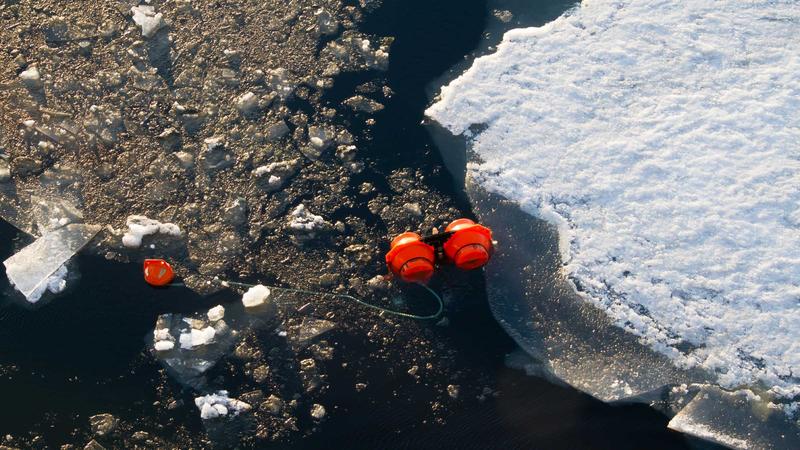

A mooring appears at the ocean's surface.
Photo: Alfred-Wegener-Institut / M. Schiller
On Tuesday, 10 July 2018 the research icebreaker Polarstern will leave its homeport in Bremerhaven, headed for the Arctic. The main focus of the journey will be on long-term oceanographic measurements and biological research in the water column and on the seafloor of the Fram Strait between Greenland and Svalbard.
Every second, the West Spitsbergen Current transports roughly six million cubic metres of water northwards, through the eastern Fram Strait. Over the past 30 years the average temperature of these water masses has risen by one degree Celsius – today, measuring between three and six degrees Celsius, the Atlantic water is comparatively warm for this area at the transition to the Arctic Ocean.
Just 200 kilometres to the west, water measuring a frigid minus 1.8 degrees Celsius flows out of the Arctic Ocean, together with sea ice, headed south. In theory, these water masses should never come into contact with one another.
But in reality, thanks to small-scale eddies they do mix, and only part of the warm water continues northward to the high Arctic. As a result, warm water can instead find its way to the glaciers calving into the sea on the eastern coast of Greenland, melting them from below.
Exactly where and how these eddies occur is one of the key questions that the 48 researchers led by chief scientist Dr Wilken-Jon von Appen from the Alfred Wegener Institute, Helmholtz Centre for Polar and Marine Research (AWI) will now explore in the Fram Strait.
They will retrieve what are known as moorings: chains that are covered with sensors for measuring temperature, flow speeds and, only since 2016, many other parameters as well. Since 1997, AWI researchers and their Norwegian colleagues have operated a grid of moorings, located near the 79° North parallel. As part of the Helmholtz infrastructure project FRAM, in 2016 they installed new moorings in areas where they suspect warm Atlantic water might branch off to the west.
“Our ocean models can very accurately depict where this westward flow might occur. Now I’m eager to see whether or not we actually placed the sensors where parts of the south-north current of warm Atlantic water forks off to the west,” says AWI oceanographer Wilken von Appen. “It would be a great success if our two year long measurements could verify this theory of water exchange.”
He and his team are just as curious to see what data the moorings’ biological and chemical sensors have gathered. These sensors, which are still in the pilot phase, will hopefully offer a wholly new perspective on how the interplay of water masses affects productivity in the marginal ice zone.
The oceanography team will retrieve a total of 20 moorings, so they can begin analysing the readings gathered, some of which date back two years. Once they have them on board, they’ll deploy a new batch of moorings with fresh sensors and batteries, so the long-term monitoring of the Fram Strait can continue.
The expedition crew also includes many biologists, who will be observing and investigating the biodiversity in the water column and on the seafloor. One of their goals is to determine which phytoplankton and amphipod species the increasingly warm Atlantic water is transporting to the Arctic. The distribution and number of species have an effect on what ultimately sinks to the ocean’s depths, serving as a food source for bottom-dwellers.
In addition to surveying these organisms, the biologists will continue their research on litter in the Arctic deep sea: since 2002, a camera system towed behind the Polarstern has been used to photograph the ocean floor during predefined transects. Subsequent analyses will tell us whether or not the litter pollution of the Arctic has worsened. There will also be chemists on board, who will investigate which trace elements the water masses move with them.
After nearly four weeks at sea, the Polarstern will call to port in Tromsø, Norway. Two geoscientific expeditions, one off the coast of Greenland and another in the Central Arctic, are slated for later in the Arctic season.
Notes for Editors
Printable images are available at: https://www.awi.de/nc/en/about-us/service/press/press-release/research-icebreake…
Video footage can be provided on request: media(at)awi.de
Your scientific contact person is Dr Wilken-Jon von Appen, tel. +49 (471) 4831-2903 (e-mail: wilken-jon.von.appen(at)awi.de). Your contact person at the Communications Dept. is Dr Folke Mehrtens, tel. +49 (471) 4831-2007 (e-mail: media(at)awi.de).
Follow the Alfred Wegener Institute on Twitter (https://twitter.com/AWI_Media) and Facebook (www.facebook.com/AlfredWegenerInstitute).
The Alfred Wegener Institute, Helmholtz Centre for Polar and Marine Research (AWI) conducts research in the Arctic, Antarctic and oceans of the high and mid-latitudes. It coordinates polar research in Germany and provides major infrastructure to the international scientific community, such as the research icebreaker Polarstern and stations in the Arctic and Antarctica. The Alfred Wegener Institute is one of the 18 research centres of the Helmholtz Association, the largest scientific organisation in Germany.












